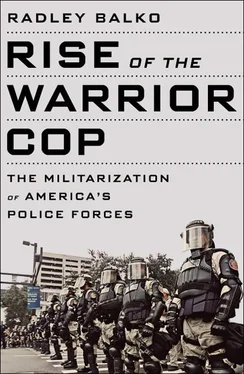In other words, if the DEA wants to stick it to medical marijuana users because they’re flouting federal law, they can. If Steven Seagal wants to drive a tank into a man’s living room to demonstrate his love of animals, he can. If the Consumer Products Safety Commission (CPSC) wants to send a SWAT team to a physicist’s house to show that it’s cracking down on illegal bottle rockets, it can. 80At worst, the DEA, the CPSC, and Steven Seagal will be chastised by a judge after the fact, though that seldom happens. Even on the rare occasions when someone actually gets into court and wins an excessive-force lawsuit stemming from a raid, the damages are usually borne by taxpayers, not by the cops who used excessive force. In some cases, community outrage and bad press have persuaded police agencies to change a policy here or there regarding the deployment of their SWAT teams. But if they want to reneg and go back to breaking down the doors of people suspected of stealing decorative fish, there’s very little to stop them. 81

TOWARD THE END OF THE 2000S, THERE WERE HINTS THAT the public was beginning to want a change, though that desire could manifest in unexpected ways. A former colleague at the Cato Institute, Tim Lynch, has told me that when he gives talks about the Waco raid, he finds that people are somewhat sympathetic to the argument that the government overreacted, but that they still can’t get past the weirdness of the Branch Davidians themselves—their stockpile of weapons and the claims of sexual abuse and drug distribution in the community. Even the children who died are sometimes dismissed with guilt by association. But when he mentions that the ATF agents killed the Davidians’ dogs, Lynch tells me, people become visibly angry. I have found the same thing to be true in my reporting on drug raids.
At first, that may seem to indicate that people callously value the lives of pets more than the lives of people. But the fact that killing the dog during these raids has become nearly routine in many police agencies demonstrates just how casually those agencies have come to accept drug war collateral damage. When I started logging cop-shoots-dog incidents on my blog (under the probably sensational term “puppycide”), people began sending me new stories as they happened. Cops are now shooting dogs at the slightest provocation. As of this writing, I’m sent accounts of a few incidents each week.
It’s difficult to say if this is happening more frequently. There are no national figures, and estimates are all over the map. One dog handler recently hired to train a police department in Texas estimates there are up to 250,000 cop-shoots-dog cases each year. That seems high. In 2009 Randal Lockwood of the American Society for the Prevention of Cruelty to Animals (ASPCA) told the Las Vegas Review-Journal that he sees 250 to 300 incidents per year in media reports, and he estimates that another 1,000 aren’t reported. The Indianapolis Star reported that between 2000 and 2002 police in that city shot 44 dogs. A recent lawsuit filed by the Milwaukee owner of a dog killed by cops found that police in that city killed 434 dogs over a nine-year period, or about one every seven and a half days. But those figures aren’t all that helpful. They don’t say how many of those dogs were actually vicious, how many were strays, or how many were injured and perhaps killed as an act of mercy versus how many were unjustified killings of pets. 82
What is clear is that police are almost always cleared of any wrongdoing in these shootings. An officer’s word that he felt a dog posed a threat to his safety is generally all it takes. Whether or not the officer’s fear was legitimate doesn’t seem to matter. Thanks to smart phones and surveillance cameras, a growing batch of these incidents have been caught on video have shown that officers’ claims that the dog was threatening often aren’t matched by the dog’s body language. In recent years, police officers have shot and killed chihuahuas, golden retrievers, labs, miniature dachshunds, Wheaton terriers, and Jack Russell terriers. In 2012 a California police officer shot and killed a boxer puppy and pregnant chihuahua, claiming the boxer had threatened him. The chihuahua, he said, got caught in the crossfire. Police officers have also recently shot dogs that were chained, tied, or leashed, going so far as to kill pets while merely questioning neighbors about a crime in the area, cutting across private property while in pursuit of a suspect, and after responding to false burglar alarms.
It’s possible that these incidents could just be attributed to rogue cops. But the fact that the police are nearly always excused in these cases—even in the more ridiculous examples—suggests there may be an institutional problem. So does the fact that only a handful of police departments give their cops any training at all when it comes to reading and handling the dogs they may encounter. In a 2012 article for the Huffington Post , my intern J. L. Greene and I looked at twenty-four recent cases of “puppycide” and called the relevant police departments to inquire about training. Only one department could confirm that its officers received training at the time of the incident in question. (Eleven departments did not return our phone calls.) That jibes with an earlier article I wrote for The Daily Beast in which both the ASPCA and the Humane Society told me that they offer such training to any police department that wants it, while few take advantage of the offer. Joseph Pentangelo, the ASPCA’s assistant director for law enforcement, who also served twenty-one years with the NYPD, told me, “New York is the only state I know of that mandates formalized training, and that’s during academy. There are some individual departments in other parts of the country that avail themselves of our training, but not many. Not enough.” 83
Given how likely it is that police officers will often interact with animals, you would think that such training would be common. It is at the US Postal Service. A spokesman for the USPS told me that while dog bites do happen on occasion, serious dog attacks on mail carriers are almost nonexistent. Postal workers are given regular training in distracting dogs with toys, subduing them with voice commands, or, at worst, incapacitating them with Mace. Mail carriers are shown a two-hour video and then given annual instruction on topics like recognizing and reading a dog’s body language and differentiating between aggressive charging and playful bounding, and between a truly dangerous dog and a merely territorial one.
The fact that the Postal Service offers such training and most police departments don’t lends some credence to the theory that dog shootings are part of the larger problem of a battlefield mentality that lets police use lethal force in response to the slightest threat—usually with few consequences. “It’s an evolving phenomenon,” says Norm Stamper, the former Seattle police chief. “It started when drug dealers began to recruit pit bulls to guard their supply. These dogs weren’t meant to attack cops. They were meant to attack other drug dealers who came to rob them. But of course they did attack cops. And yes, that’s awfully scary if one of those things latches on to your leg.”
But Stamper says that like many aspects of modern policing, dog shootings may have had a legitimate origin, but the practice has since become a symptom of the mind-set behind a militarized police culture. “Among other things, it really shows a lack of imagination. These guys think that the only solution to a dog that’s yapping or charging is shooting and killing it. That’s all they know. It goes with this notion that police officers have to control every situation, to control all the variables. That’s an awesome responsibility, and if you take it on, you’re caving to delusion. You no longer exercise discrimination or discretion. You have to control, and the way you control is with authority, power, and force. With a dog, the easiest way to take control is to simply kill it. I mean, especially if there are no consequences for doing so.” 84
Читать дальше













